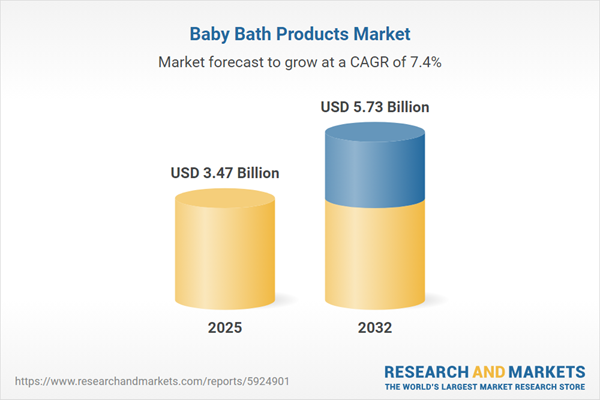Speak directly to the analyst to clarify any post sales queries you may have.
The baby bath products market is evolving as senior decision-makers navigate demand for safer formulations and environmental stewardship. Those overseeing strategy are responding to shifts in consumer behavior and tightening regulations, shaping how businesses achieve resilience, value, and growth.
Market Snapshot: Baby Bath Products Market Overview
The baby bath products market is projected to increase from USD 3.23 billion in 2024 to USD 3.47 billion in 2025, maintaining a steady path with a CAGR of 7.41%, and is expected to reach USD 5.73 billion by 2032. This growth reflects active investment in innovation, rapid shifts in consumer preference, and the rise of omnichannel distribution. Senior executives gain an informed view of market momentum as product development, targeted marketing, and changing go-to-market strategies shape competition and the flow of capital. Leadership can use this perspective to assess new opportunities and align investment initiatives with key demand drivers in the sector.
Scope & Segmentation
- Product Types: Includes baby shampoo, bath soap, gentle washes, and accessories, each showing areas for enhanced development and new launches tailored to parent and caregiver needs.
- Distribution Channels: Covers online retailers, convenience outlets, branded e-commerce, pharmacies, specialty shops, general marketplaces, and hypermarkets, supporting broad and specialist merchandising approaches.
- Formulation Attributes: Segments span conventional, organic, and natural products, with clean-label demands influencing ingredient sourcing decisions and compliance measures.
- Packaging Types: Range from bar formats to pumps and squeeze tubes, with analysis of usage safety, consumer convenience, and product integrity at various points of sale.
- Target Age Groups: Defined by newborn (0–3 months), infant (3–12 months), and toddler (1–3 years) segments, underscoring tailored communication, formula development, and support for parental decision-making.
- Regional Coverage: Americas, EMEA, and Asia-Pacific regions are individually examined, noting regulatory differences, logistics, and shifting local demand as crucial competitive factors.
- Company Coverage: Profiles of Johnson & Johnson Consumer Inc., Unilever PLC, Procter & Gamble Company, Sebapharma GmbH & Co. KG, Laboratoires Expanscience, Artsana S.p.A., The Honest Company Inc., Munchkin Inc., Weleda AG, and Pigeon Corporation for insights into ongoing product strategies and competitive approaches.
Key Takeaways: Strategic Insights for Senior Decision-Makers
- Leading brands are advancing plant-derived and dermatologist-reviewed formulations, strengthening their safety credentials while addressing rising expectations around environmental responsibility.
- Transparency in labeling and proactive digital engagement serve to build consumer trust, increasing loyalty especially within online and omnichannel settings.
- Retail strategies now prioritize a wider array of organic, hypoallergenic, and sustainability-marketed options, responding to diverse caregiver and professional priorities.
- Shifts in regulatory guidance prompt reformulation, with firms excluding microplastics and utilizing advanced sourcing for safer preservatives.
- Collaborations with regional manufacturers and specialized distribution partners support rapid response to nuanced trends across markets, fostering quicker adaptation cycles.
- Market leaders apply data analytics and technology to refine pricing, identify opportunities for new product launches, and optimize acquisition strategies in response to evolving competitive dynamics.
Tariff Impact: Adapting Strategies Amid 2025 US Tariff Changes
Amid new US tariff adjustments, organizations in the baby bath products space face higher supply chain costs. Senior leadership is responding through enhanced local sourcing, forging robust supplier relationships, and optimizing logistics to secure delivery and margin performance. Executives renegotiate supplier terms and leverage established trade routes, helping reduce exposure to distribution risk created by updated trade policies.
Methodology & Data Sources
This report synthesizes market data from interviews with industry experts, robust consumer surveys, and scrutiny of regulatory filings, relevant patents, and public corporate disclosures. This comprehensive methodology ensures actionable and reliable projections for future planning.
Why This Report Matters
- Enables executive teams to allocate resources efficiently by identifying high-performing segments and untapped growth regions within the baby bath products market.
- Offers decision support by clarifying how regulatory shifts and rising consumer demands impact sales strategies, production, and operations.
- Equips leaders with competitive intelligence—covering digital trends, risk management, and technology-driven tactics—to reinforce and sustain market positioning under evolving conditions.
Conclusion
Effective growth in the baby bath products industry depends on fostering collaborative partnerships, adapting swiftly to regulatory landscapes, and maintaining flexible consumer engagement strategies. These actions underpin resilience and future expansion in dynamic market environments.
Additional Product Information:
- Purchase of this report includes 1 year online access with quarterly updates.
- This report can be updated on request. Please contact our Customer Experience team using the Ask a Question widget on our website.
Table of Contents
3. Executive Summary
4. Market Overview
7. Cumulative Impact of Artificial Intelligence 2025
Samples

LOADING...
Companies Mentioned
The key companies profiled in this Baby Bath Products market report include:- Johnson & Johnson Consumer Inc.
- Unilever PLC
- The Procter & Gamble Company
- Sebapharma GmbH & Co. KG
- Laboratoires Expanscience
- Artsana S.p.A.
- The Honest Company, Inc.
- Munchkin, Inc.
- Weleda AG
- Pigeon Corporation
Table Information
| Report Attribute | Details |
|---|---|
| No. of Pages | 196 |
| Published | October 2025 |
| Forecast Period | 2025 - 2032 |
| Estimated Market Value ( USD | $ 3.47 Billion |
| Forecasted Market Value ( USD | $ 5.73 Billion |
| Compound Annual Growth Rate | 7.4% |
| Regions Covered | Global |
| No. of Companies Mentioned | 11 |









